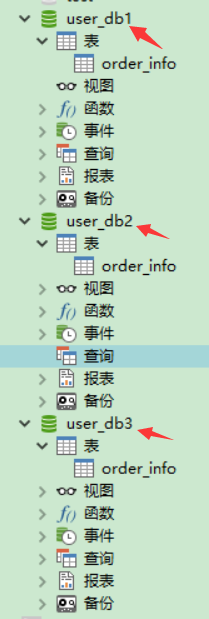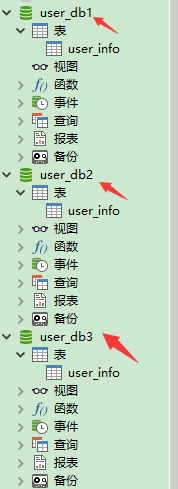数据库集群会产生的问题:
自增ID问题
数据关联查询问题(水平拆分)
数据同步问题
数据库集群 自动增长id产生重复的话,解决: UUID形式 (没有排序 不是自增) 设置数据库步长
其他方案: redis 或者雪花算法
数据库分库分表的策略:
数据库分表分库策略
数据库分表分库原则遵循 垂直拆分与水平拆分
垂直拆分就是根据不同的业务,分为不同的数据库,比如会员数据库、订单数据库、支付数据库等,垂直拆分在大型电商系统中用的非常常见。
优点:
拆分后业务清晰,拆分规则明确,系统之间整合或扩展容易。
缺点:
部分业务表无法join,只能通过接口方式解决,提高了系统复杂度存在分布式事务问题。
数据库分表分库原则遵循 垂直拆分与水平拆分
垂直拆分是把不同的表拆到不同的数据库中,而水平拆分是把同一个表拆到不同的数据库中。
相对于垂直拆分,水平拆分不是将表的数据做分类,而是按照某个字段的某种规则来分散到多个库之中,每个表中包含一部分数据。简单来说,我们可以将数据的水平切分理解为是按照数据行的切分,就是将表中 的某些行切分到一个数据库,而另外的某些行又切分到其他的数据库中,主要有分表,分库两种模式
该方式提高了系统的稳定性跟负载能力,但是跨库join性能较差。
在数据库分库分表原则中,遵循两个设计理论 垂直拆分 水平拆分
垂直拆分就是根据不同的业务,拆分成不同的数据库,比如会员数据库,订单数据库,支付数据库,消息数据库等。
垂直拆分缺点:
跨数据查询 必须采用接口形式通讯、分布式事务问题
垂直拆分把不容的表拆到不同的数据库中,而水平拆分是把同一个表拆分到不同的数据库中,或者把一张表的数据拆分n多个小表
如果一张表6条数据:
变成三个库 每个库中存放两条数据,一共三张表,三张表的结构是完全相同的。三个库进行均摊存放
在存的时候根据ID取模存放
在查询时候依然根据取模算法进行获取
拆分的好处: 如果数据量大的情况下,就算用索引也就那样。但是进行水平拆分就好了很多

水平分片策略:
MyCat支持10种分片策略
1、求模算法
2、分片枚举
3、范围约定
4、日期指定
5、固定分片hash算法
6、通配取模
7、ASCII码求模通配
8、编程指定
9、字符串拆分hash解析
详细:http://www.mycat.io/document/mycat-definitive-guide.pdf
关于分片枚举:
分片枚举这种规则适用于特定的场景,比如有些业务需要按照省份或区县来做保存,而全国的省份区县固定的,这类业务使用这一规则。配置如下
1.案例步骤:
创建数据库userdb_1 、 userdb_2、userdb_3
2.修改partition-hash-int.txt 规则
wuhan=0
shanghai=1
suzhou=2
详细配置请参考文档
根据地区进行分库 湖北数据库、江苏数据库 山东数据库 (三张表)
分片枚举算法就是根据不同的枚举(常量),进行分类存储。
可以使用分片枚举实现根据地区分类存储到不同数据库进行存放
环境搭建:
定义枚举(地区) 每个地区指定数据库存放位置
schema.xml:
<?xml version="1.0"?> <!DOCTYPE mycat:schema SYSTEM "schema.dtd"> <mycat:schema xmlns:mycat="http://io.mycat/"> <!-- mycat_testdb 是mycat的逻辑库名称,链接需要用的 --> <schema name="mycat_testdb" checkSQLschema="false" sqlMaxLimit="100" dataNode="dn1"> <!-- 逻辑库里面的表 order_info 并且有三台节点做集群 规则文件是role2 --> <table name="order_info" dataNode="dn1,dn2,dn3" rule="role2" /> </schema> <!-- database 是MySQL数据库的库名 三台节点 分别对应真实的数据库 user_dbn --> <dataNode name="dn1" dataHost="localhost1" database="user_db1" /> <dataNode name="dn2" dataHost="localhost1" database="user_db2" /> <dataNode name="dn3" dataHost="localhost1" database="user_db3" /> <!-- dataNode节点中各属性说明: name:指定逻辑数据节点名称; dataHost:指定逻辑数据节点物理主机节点名称; database:指定物理主机节点上。如果一个节点上有多个库,可使用表达式db$0-99, 表示指定0-99这100个数据库; dataHost 节点中各属性说明: name:物理主机节点名称; maxCon:指定物理主机服务最大支持1000个连接; minCon:指定物理主机服务最小保持10个连接; writeType:指定写入类型; 0,只在writeHost节点写入; 1,在所有节点都写入。慎重开启,多节点写入顺序为默认写入根据配置顺序,第一个挂掉切换另一个; dbType:指定数据库类型; dbDriver:指定数据库驱动; balance:指定物理主机服务的负载模式。 0,不开启读写分离机制; 1,全部的readHost与stand by writeHost参与select语句的负载均衡,简单的说,当双主双从模式(M1->S1,M2->S2,并且M1与 M2互为主备),正常情况下,M2,S1,S2都参与select语句的负载均衡; 2,所有的readHost与writeHost都参与select语句的负载均衡,也就是说,当系统的写操作压力不大的情况下,所有主机都可以承担负载均衡; --> <dataHost name="localhost1" maxCon="1000" minCon="10" balance="3" writeType="0" dbType="mysql" dbDriver="native" switchType="1" slaveThreshold="100"> <heartbeat>select user()</heartbeat> <!-- 可以配置多个主从 --> <writeHost host="hostM1" url="192.168.91.8:3306" user="root" password="root"> <!-- 可以配置多个从库 --> <readHost host="hostS2" url="192.168.91.9:3306" user="root" password="root" /> </writeHost> </dataHost> </mycat:schema>
rule.xml:
<?xml version="1.0" encoding="UTF-8"?> <!-- - - Licensed under the Apache License, Version 2.0 (the "License"); - you may not use this file except in compliance with the License. - You may obtain a copy of the License at - - http://www.apache.org/licenses/LICENSE-2.0 - - Unless required by applicable law or agreed to in writing, software - distributed under the License is distributed on an "AS IS" BASIS, - WITHOUT WARRANTIES OR CONDITIONS OF ANY KIND, either express or implied. - See the License for the specific language governing permissions and - limitations under the License. --> <!DOCTYPE mycat:rule SYSTEM "rule.dtd"> <mycat:rule xmlns:mycat="http://io.mycat/"> <tableRule name="role2"> <rule> < !-- 表示根据name字段进行分片存储的 --> <columns>name</columns> <algorithm>hash-int</algorithm> </rule> </tableRule> <!-- 与上面的hash-int对应 --> <function name="hash-int" class="io.mycat.route.function.PartitionByFileMap"> <!-- 指定枚举文件 --> <property name="mapFile">partition-hash-int.txt</property> <!-- 枚举文件非数值类型要写1 --> <property name="type">1</property> <!-- 默认存放的位置 在第一个的位置存放 --> <property name="defaultNode">1</property> </function> </mycat:rule>
注意在实际应用时候 把rule.xml的注释去除掉
server.xml:
<?xml version="1.0" encoding="UTF-8"?> <!-- - - Licensed under the Apache License, Version 2.0 (the "License"); - you may not use this file except in compliance with the License. - You may obtain a copy of the License at - - http://www.apache.org/licenses/LICENSE-2.0 - - Unless required by applicable law or agreed to in writing, software - distributed under the License is distributed on an "AS IS" BASIS, - WITHOUT WARRANTIES OR CONDITIONS OF ANY KIND, either express or implied. - See the License for the specific language governing permissions and - limitations under the License. --> <!DOCTYPE mycat:server SYSTEM "server.dtd"> <mycat:server xmlns:mycat="http://io.mycat/"> <!-- 读写都可用的用户 --> <user name="root" defaultAccount="true"> <property name="password">123456</property> <property name="schemas">mycat_testdb</property> <!-- 表级 DML 权限设置 --> <!-- <privileges check="false"> <schema name="TESTDB" dml="0110" > <table name="tb01" dml="0000"></table> <table name="tb02" dml="1111"></table> </schema> </privileges> --> </user> <!-- 只读用户 --> <user name="user"> <property name="password">user</property> <property name="schemas">mycat_testdb</property> <property name="readOnly">true</property> </user> </mycat:server>
查询端口号被哪个进程占用:
netstat -tunlp | grep 8080
kill -9 666
分片规则:
wuhan=0
shanghai=1
suzhou=2
启动mycat
然后navicat工具连接之:
往mycat表的虚拟表里面写数据:会映射到实际物理数据库的表里面

映射的物理数据库:

如果分片枚举没有的 根据配置会存储到 db2中!

结构图:

求模算法:根据ID去进行十进制求模运算,运算结果为分区索引
注意:数据库节点分片数量无法更改 (和ES集群非常类似)
schema.xml
<?xml version="1.0"?> <!DOCTYPE mycat:schema SYSTEM "schema.dtd"> <mycat:schema xmlns:mycat="http://io.mycat/"> <!-- TESTDB1 是mycat的逻辑库名称,链接需要用的 --> <schema name="mycat_testdb" checkSQLschema="false" sqlMaxLimit="100" dataNode="dn1"> <!-- 分片的算法是role1 --> <table name="user_info" dataNode="dn1,dn2,dn3" rule="role1"/> </schema> <!-- database 是MySQL数据库的库名 --> <dataNode name="dn1" dataHost="localhost1" database="user_db1" /> <dataNode name="dn2" dataHost="localhost1" database="user_db2" /> <dataNode name="dn3" dataHost="localhost1" database="user_db3" /> <!-- dataNode节点中各属性说明: name:指定逻辑数据节点名称; dataHost:指定逻辑数据节点物理主机节点名称; database:指定物理主机节点上。如果一个节点上有多个库,可使用表达式db$0-99, 表示指定0-99这100个数据库; dataHost 节点中各属性说明: name:物理主机节点名称; maxCon:指定物理主机服务最大支持1000个连接; minCon:指定物理主机服务最小保持10个连接; writeType:指定写入类型; 0,只在writeHost节点写入; 1,在所有节点都写入。慎重开启,多节点写入顺序为默认写入根据配置顺序,第一个挂掉切换另一个; dbType:指定数据库类型; dbDriver:指定数据库驱动; balance:指定物理主机服务的负载模式。 0,不开启读写分离机制; 1,全部的readHost与stand by writeHost参与select语句的负载均衡,简单的说,当双主双从模式(M1->S1,M2->S2,并且M1与 M2互为主备),正常情况下,M2,S1,S2都参与select语句的负载均衡; 2,所有的readHost与writeHost都参与select语句的负载均衡,也就是说,当系统的写操作压力不大的情况下,所有主机都可以承担负载均衡; --> <dataHost name="localhost1" maxCon="1000" minCon="10" balance="3" writeType="0" dbType="mysql" dbDriver="native" switchType="1" slaveThreshold="100"> <heartbeat>select user()</heartbeat> <!-- 可以配置多个主从 --> <writeHost host="hostM1" url="192.168.91.8:3306" user="root" password="root"> <!-- 可以配置多个从库 --> <readHost host="hostS2" url="192.168.91.9:3306" user="root" password="root" /> </writeHost> </dataHost> </mycat:schema>
rule.xml
<?xml version="1.0" encoding="UTF-8"?> <!-- - - Licensed under the Apache License, Version 2.0 (the "License"); - you may not use this file except in compliance with the License. - You may obtain a copy of the License at - - http://www.apache.org/licenses/LICENSE-2.0 - - Unless required by applicable law or agreed to in writing, software - distributed under the License is distributed on an "AS IS" BASIS, - WITHOUT WARRANTIES OR CONDITIONS OF ANY KIND, either express or implied. - See the License for the specific language governing permissions and - limitations under the License. --> <!DOCTYPE mycat:rule SYSTEM "rule.dtd"> <mycat:rule xmlns:mycat="http://io.mycat/"> <tableRule name="role1"> <rule> <!-- 指定分片规则要玩儿的列名 --> <columns>id</columns> <!-- 指定下面的分片算法 --> <algorithm>mod-long</algorithm> </rule> </tableRule> <function name="mod-long" class="io.mycat.route.function.PartitionByMod"> <!--指定分片数量,不可以被更改 count数据库的分配数量一共三台 一旦定了就不能修改了! --> <property name="count">3</property> </function> </mycat:rule>
server.xml
<?xml version="1.0" encoding="UTF-8"?> <!-- - - Licensed under the Apache License, Version 2.0 (the "License"); - you may not use this file except in compliance with the License. - You may obtain a copy of the License at - - http://www.apache.org/licenses/LICENSE-2.0 - - Unless required by applicable law or agreed to in writing, software - distributed under the License is distributed on an "AS IS" BASIS, - WITHOUT WARRANTIES OR CONDITIONS OF ANY KIND, either express or implied. - See the License for the specific language governing permissions and - limitations under the License. --> <!DOCTYPE mycat:server SYSTEM "server.dtd"> <mycat:server xmlns:mycat="http://io.mycat/"> <!-- 读写都可用的用户 --> <user name="root" defaultAccount="true"> <property name="password">123456</property> <property name="schemas">mycat_testdb</property> <!-- 表级 DML 权限设置 --> <!-- <privileges check="false"> <schema name="TESTDB" dml="0110" > <table name="tb01" dml="0000"></table> <table name="tb02" dml="1111"></table> </schema> </privileges> --> </user> <!-- 只读用户 --> <user name="user"> <property name="password">user</property> <property name="schemas">mycat_testdb</property> <property name="readOnly">true</property> </user> </mycat:server>
mycat连接到读的虚拟数据库
然后在真实物理数据库上面创建 user_db1 user_db2 user_db3
在Myca的写权限的虚拟数据库创建表:

此时的其他的物理数据库里面也会刷新数同样的表

然后在write里面写入数据

会根据ID取模,分片到不同的物理数据库里面